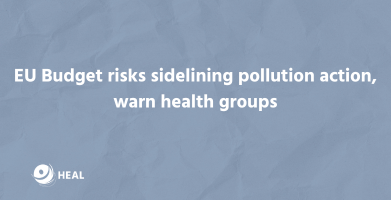In 2025, HEAL welcomed several new organisations into its international network of over 70 members committed to advancing health through environmental action. These new members bring valuable expertise in public health, environmental justice, and sustainable policy, further strengthening the capacity of the alliance to help face the challenges from biodiversity loss, pollution and climate change. Learn more about their missions and work below.
The European Commission has today released its proposal for the creation of dedicated hazard classes for endocrine disrupting chemicals (EDCs) under the EU legislation for classification, labelling and packaging of chemicals (CLP). The creation of such hazard classes was one of the flagship promises made under the 2020 EU Chemicals Strategy for Sustainability and a longtime demand from HEAL and partners from the EDC-Free Europe Coalition.
Read HEAL’s and EDC-Free Europe’s reactions below:
Natacha Cingotti, Health and Chemicals Programme Lead at HEAL said:
“Today, the creation of dedicated hazard classes for endocrine disruptors under the CLP regulation introduces a harmonised identification for those harmful substances across sectors and uses and marks an important u-turn, which HEAL has long called for.
The establishment of subcategories to reflect the different levels of scientific evidence available to characterise the substance properties – known, presumed, and suspected – is an important win for health, and we will now closely monitor the development of the guidance document so that it allows for a protective implementation of the new criteria.”
EDC-Free Europe, a coalition of more than 70 civil society groups concerned over the impacts of endocrine disrupting chemicals (EDCs) on our health and environment, welcomes European Commission’s adoption of proposal to upgrade the EU regulation for the classification, labelling and packaging of chemicals (CLP) as a significant step forward towards better protection of people and environment against exposure to harmful EDCs. The reform presented today by the European Commission is one of the building blocks for the implementation of the European Chemicals Strategy for Sustainability adopted in October 2020.
The EDC-Free Europe campaign has long called for the CLP regulation to catch up with well-established scientific evidence on the impact of EDCs present everywhere in our daily life but so far overlooked by this overarching regulation for classification of chemicals.
It is particularly important that the new hazard classes introduced for EDCs include a hazard category for suspected EDCs, in addition to the category for known and presumed EDCs. The hazard category for suspected EDCs will allow classification of substances for which there is substantial but not yet enough scientific evidence to be classified as a known or presumed EDC. In line with the current CLP approach followed for the classification of substances which have carcinogenic, mutagenic or reprotoxic properties (CMRs), the system of categories for classification of EDCs in the CLP will provide for more transparency in the supply chain and more information for workers and the public.
The coalition also welcomes the new hazard classes for chemicals with persistent, bioaccumulative and toxic (PBT) properties, and very persistent and very bioaccumulative (vPvB) properties. The new classes for persistent, mobile and toxic (PMT) and very persistent and very mobile (vPvM) substances are another important addition, in particular for protecting drinking water resources.
However, the transition periods set for the implementation of the new provisions are very long. The coalition also regrets that the level of evidence required to actually classify substances as suspected EDCs is still very high. As a result many substances of concern are likely to remain outside of the scope of scrutiny provided by the Regulation.
“The changes to the annexes of the CLP regulation will eventually allow for better control of these harmful chemicals on the EU market. However, they still need to be completed with urgently needed adjustments of other key pieces of EU legislation to minimise exposure, in particular REACH, and legislation on toys, food contact materials or cosmetics, in order to truly protect health and the environment,” explains Sandra Jen, campaign coordinator at the EDC-Free Europe coalition.
EDC-Free Europe also welcomes the steps taken by the EU to include EDCs as a hazard class in the UN Globally Harmonized System of Classification and Labelling of Chemicals (GHS).
Endocrine disruptors are chemicals that interfere with the human hormone system, and can be found in plastics, furniture, cosmetics, toys, food contact materials, synthetic pesticides, and other consumer products we use on a daily basis. Health costs linked to exposure to EDCs have been estimated to be over 163 billion Euros in Europe alone.
Read EDC-Free Europe’s reaction here.
Find out more about HEAL’s work on the reform of the CLP regulation here.



